Building A Course In The Jungle
Building A Course In The Jungle
PDGA Marco Polo Program & EDGE Bring Disc Golf to Honduras
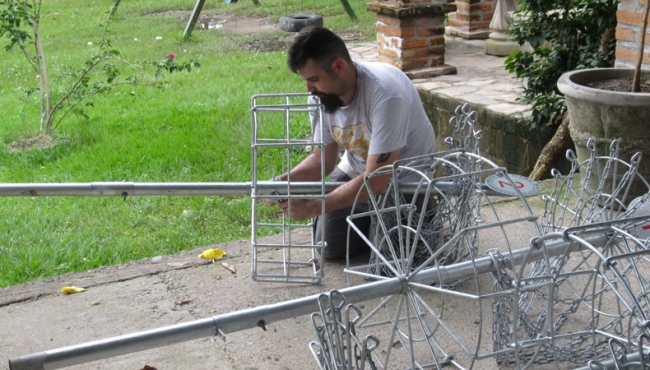
I don’t think that many people wake up one day and think to themselves: “I’m going to build a disc golf course in the jungles of Honduras!”
This project was a great example of perfection arising from chaos. As cliché as this sounds, I believe that since birth everything had fallen into place for me to take on this incredible venture.
I am fortunate to be of the first generation Pineda’s born in the United States. My father emigrated from Honduras when he was a young adult. He was able to gain an opportunity to study at the University of Southwestern Louisiana in Lafayette, where he met my mother, a New Orleans native. As love had it, they married and I was born the second of five children born in the US.
Honduras is a country in Central America that has a checkered past and a difficult road ahead of it. Despite its rich pre-Hispanic Mayan culture, Honduras’ last 100 years have been plagued with regional conflict, foreign exploitation, political corruption and government instability. As a result, Honduras suffers from high levels of poverty and is one of the least developed countries in Latin America.
Throughout the years, much of my family has moved to the United States, however, we still have very strong ties to Honduras. My uncle Mauricio and aunt Ana Erazo are the Central American directors of an organization called Youth For Christ. This organization has a camp in a small city called La Entrada, located near Copan, a popular tourist destination where travelers from around the world come to marvel at the ancient Mayan ruins.
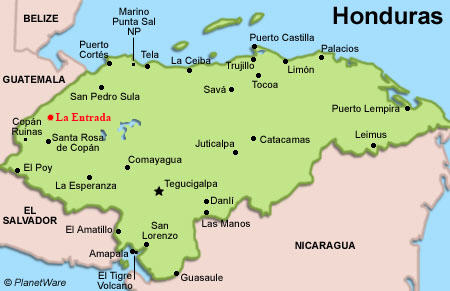
Nestled among the lush jungle surrounding La Entrada is the Youth for Christ’s camp, “Rancho Vida”. Rancho Vida is a multi-use camp that features hiking trails, zip-lines, rock climbing, waterfalls, soccer fields and living quarters. Not only do missions groups and medical teams use the facility as a base, but school groups, church groups, sports teams and families come from far and wide to enjoy the many activities the camp has to offer.
After the death of my grandmother two years ago, my father came up with the idea to come together as a family and serve the communities in Honduras that have always had a special place in our hearts. We called our project “Sirviendo En Familia”, which translates to “Serving as a Family”. We started kicking around ideas for donations, service works, concerts and events for the kids… and a disc golf course.
I had shared my enthusiasm about disc golf with my uncle Mauricio in the past and he was very quick to jump onboard the idea. One of the biggest advantages to bringing a sport like disc golf to this area is there are very few barriers to entry. With borrowed discs from the camp, it would be an activity that children and families could enjoy together at no cost. He loved the ideas of exercise, fellowship, community and friendly competition that it brings and was eager to start giving me all the information that we needed to plan the project.
Sponsorship & Support
At first, I thought that finding sponsors for this project would be a piece of cake. Who wouldn’t join us on a crusade so pure as to expand our sport and serve developing communities? So, I began writing every disc golf manufacturer, promoter and tournament director I could. To my surprise, people weren’t chomping at the bit to donate for this project. There just simply isn’t any immediate return on investment for something like this. A single disc could be several days wages for the people in these communities, so the growth model just won’t be there for a while.
Disc golf, as a sport, is slowly transitioning from its infancy to its adolescence and most clubs, equipment manufacturers, and promoters are still relatively small grass-roots operations that don’t have the budgets for these types of projects. Yet.
Then one day, I got a reply from Michael Downes #13898, PDGA Events Manager. He told me about the PDGA’s Marco Polo program and told me that it would be ideal for a project of this scope. He pointed me in the right direction and got me all the information that I needed to make my proposal. The goals of the Marco Polo Program are to support the introduction of disc golf into new countries and to strengthen its development in countries around the world.
Things were starting to look up. I had a lead. My next big break came from none other than the kind hearts of Jay and Des Reading. I approached them with the project and asked for their guidance. They loved the idea and were eager to mentor me with their years of experience in disc golf education. They offered to provide us with the complete E.D.G.E Program (Educational Disc Golf Experience) curriculum and assistance in procuring affordable equipment and plastic. I now had the material resources, expertise and program support that I needed. This impossible task was starting to look a little more like a reality!
With the help of my family, friends, and the support/ donations of the disc golf community, we were off to Honduras!
Building The Course
Honduras, like much of Central America, has a tropical warm climate with alternating dry and wet seasons. The highlands of Copan are no exception, but due to its elevation it typically sees only mild variations between dry and wet seasons. We planned this trip during a mild part of the dry season to have the best chances of good work days.
Just as Mother Nature doesn’t plan itself around disc golf tournaments, neither was the case for our course construction project. Our first curveball was a nearly disastrous one for our project, as just days before our arrival the area had experienced the worst flooding it had seen in decades. Torrential rains and numerous landslides had left people’s homes destroyed and the landscape covered in mud. To make matters worse, it rained every day that we were there. Despite the daunting weather, we toughened up and pushed forward without hesitation.
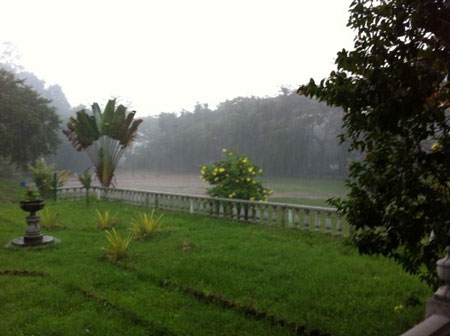
Seemingly endless rain at Rancho Vida.
Day One
We arose at 5:30 am to the mudscape that had become Rancho Vida. Any reluctance that we had to work that day was quickly eradicated by my uncle’s enthusiasm, as he walked the property with us and showed us how he had already planned the disc golf course.
Considering that he had never seen a disc golf course before, I was impressed with his vision and creativity. While I’ve never called myself a course designer, I’ve played enough courses with countless other disc golfers to know what works and what doesn’t. With cans of orange spray paint in hand, we trudged through the mud, checked different ideas, and marked out a fun 9-hole design.
We hired two local workers, Ever and Luis. These guys were superhuman! They cut pathways for the whole course by machete – including felling some 5-inch diameter trees. By lunchtime on the first day, these two wonder-workers had already cleared the course and dug the holes for the 9 baskets. Due to the rocky terrain, they had to use a weighted chisel along with shovels to make the holes. It was hard not to feel emasculated while I struggled to haul buckets of concrete up the slippery hills while these small-framed local men seemed to do it effortlessly.
At the end of day 1 we had the course roughly cleared and the basket sleeves set in the cement.
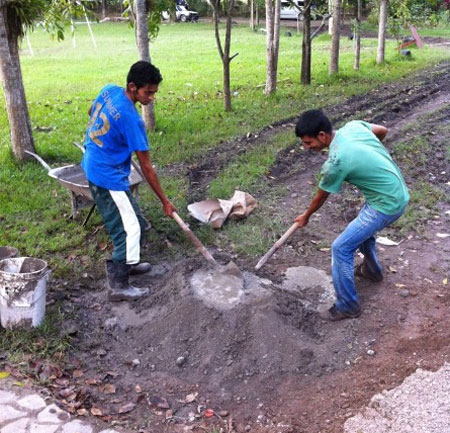
Luis (left) and Ever (right), mixing cement for the baskets.
Day Two
On our second day, we decided to hire another local worker to ensure that we had enough man-power to finish in time so that we could begin the education of the camp leaders the following day. His name was Baiker (pronounced “baker”) and we taught him some basic English including what his name translates to. We were joking that he was the best “baker” in town! The three workers dug the tee sign holes and planted the 4x4 posts so the next mission group that would volunteer there, could put in the handdrawn tee signs. We also cleared and leveled the natural tee pads for the holes and showed the camp how they could add additional tee pads to make short and long tee pads, that would effectively turn the 9 holes into a playable 18 holes.
That afternoon, about 175 kids from the community aged 6-18 came to the camp for a free concert put on by some of my family and camp partners. It was a huge hit with them, and I threw a few discs for them as a bit of a teaser for what was in store for the future. They were intrigued and seemed excited to come back and learn about disc golf!
That night, Baiker and an American volunteer named Johnny, got our first chance to throw a few discs at some of the mocked-up holes. Baiker took to it naturally. He was adamant about following the rules and glowed with that same excitement that we all felt whenever we threw our first “good shot”. I invited him back to continue to practice and learn so that he could train the locals how to play. He honored my request and took it very seriously. That was the first magic moment where I could finally see the emotional pull to the course that we have created. I couldn’t ask for more!
Day Three
On this day we had an opening ceremony at hole number one as we slid the basket into its place. It was a monumental moment that I will never forget! We continued to place all of the baskets and decided to place cinder blocks around the bases and poured cement over them to permanently lock them in place. We had to make this decision because in the event of a theft, those baskets would be very difficult to replace.
That afternoon the camp leaders joined me in a round of golf on a few holes that weren’t too muddy. I taught them basic rules and how to keep score. We had a quick throw-off on hole 1 and selected five people to play the inaugural first round on the few holes that were playable due to the mud. Everybody followed and learned as we explained the competition.
In the evening, we watched the E.D.G.E DVD that fully explains the rules and throwing techniques. We translated it into Spanish along with the video and answered their questions. The DVD served well to bring everything full circle after playing earlier that day.
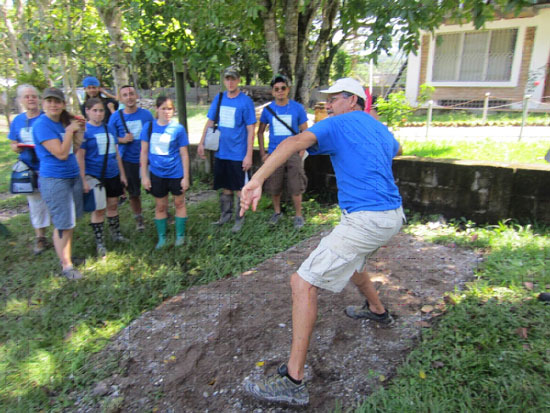
Rancho Vida and Youth for Christ director Mauricio Erazo takes his first of many throws on hole one at the new course!
Day Four
The day I was waiting for. You didn’t think I would go through all of that work and not catch a round, did you?
We got up at 5:30am to play the entire course on the true layout. We put on rubber boots and finally got to enjoy the fruits of our labor. There was nothing that could have stopped us from playing that day!
Although the course isn’t very long, it does offer a lovely set of obstacles with the jungle hillside and creek that comes into play on five of the holes. I shot a decent round, and did my usual post-round ritual of groveling about missed putts.
I also achieved another disc golf dream of mine… I set a course record! Turns out that setting a course record is easy. You just have to build your own course!
We said our goodbyes and hugged my new disc golf family. I took a deep breath and a moment to take in all that had just taken place in three incredible days. As we drove away I admired the scenery of the baskets on the new course and all I could do was smile. I cherish the experience and opportunity, and thank God for the life he has given me.
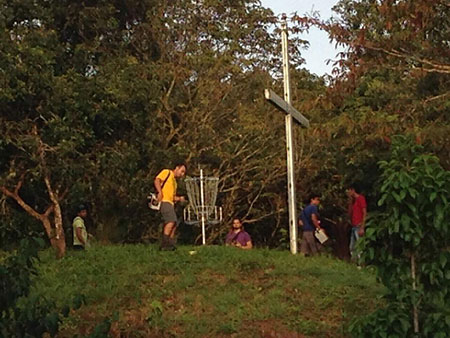
Driving into the camp, the basket for the signature hole #3 sits on top of the hill next to the cross.
What's Next for Rancho Vida?
With the course complete, camp staff trained, and the E.D.G.E. curriculum in place, the camp will still need our support to allow the sport to grow. Disc donations will go down with future mission trips to make sure that they are always stocked up, and I am hoping to plan a trip in 2015 with some more experienced disc golfers to assist in training players. We could also potentially make course improvements or increase the difficulty as we see the locals skills increase. Until then, I will continue to my support to the development of disc golf at Rancho Vida from afar.
Pictures of each of the 9 holes plus information about the course can be found on the Rancho Vida page in the PDGA Course Directory.
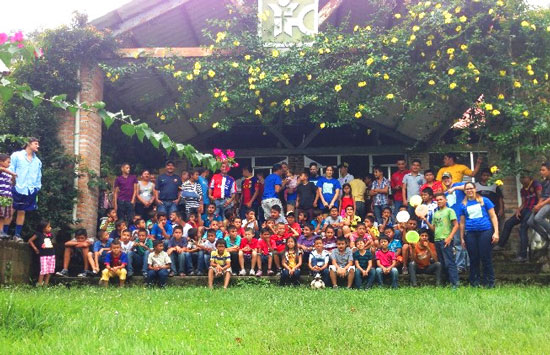

Comments
What a great article! Loved
What a great article! Loved it! Hope I can get there to play and contribute!
Thanks, Daniel
I have built a course in Wisconsin on church grounds but have not found the resources for baskets and t-signs. You have give me inspiration!